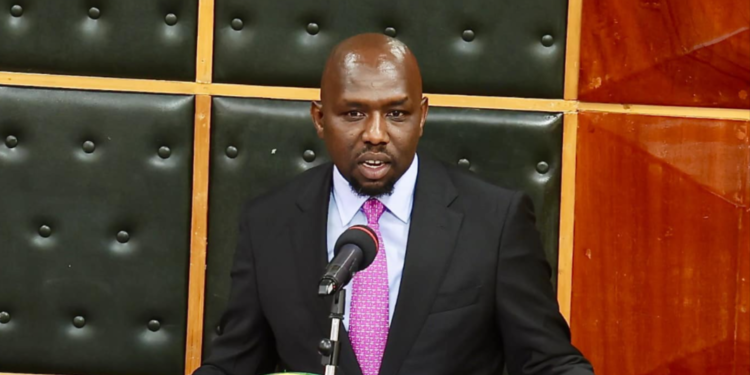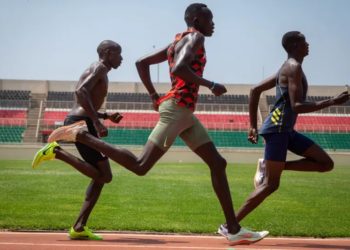Kenya’s Sports Ministry is seeking private sector partnerships to salvage the country’s crumbling sports infrastructure and avoid ballooning costs to taxpayers, Youth and Sports Cabinet Secretary Kipchumba Murkomen told Parliament on Tuesday. Murkomen emphasized the need for private investment in stadiums, noting that the government cannot continue to bear the financial burden of maintaining facilities that are deteriorating rapidly under county management.
Addressing a session in the National Assembly, Murkomen revealed that the government is exploring public-private partnerships (PPP) as the best model to ensure the sustainability and modernization of key sports facilities across the country. “All over the world, governments do not own stadiums. It costs a lot of money to the taxpayer without any significant return. If the private sector owned these facilities, they would commercialize them and make them available for sports activities,” Murkomen said.
The Cabinet Secretary pointed to countries like the United Kingdom, where the only government-owned stadium is Wembley, as a model Kenya could adopt. “The rest [of the stadiums in the UK] are owned by private entities and are always available for sports activities,” he added, advocating for a shift from state ownership to private-sector-driven maintenance and commercialization.
The statement came amid growing concerns over the poor state of Kenya’s sports infrastructure, with some stadiums remaining incomplete or in disrepair for years. The government has promised to prioritize key facilities ahead of the Africa Cup of Nations (AFCON) 2027, for which Kenya is preparing a joint bid alongside Uganda and Tanzania.
Murkomen highlighted the government’s urgent push to complete critical sports facilities in time for AFCON 2027. The Moi International Sports Centre in Kasarani and the Kipchoge Keino Stadium in Eldoret were named as priority projects, with completion deadlines set for December 2025. These stadiums, along with others, must meet international standards in time for inspections by the Confederation of African Football (CAF).
“We are confident that Kipchoge Keino Stadium, which has faced delays, will be ready by December 2025. We are focusing on roofing, installation of VVIP and VIP seating, floodlighting, and upgrading the pitch and changing rooms,” Murkomen said. These upgrades, he added, would align the stadiums with FIFA standards, enabling them to host international events.
The government has also initiated the rehabilitation of other stadiums that had been earmarked as training grounds for AFCON, including Kapsabet Stadium and Eldoret National Polytechnic Grounds.
During the parliamentary session, Murkomen did not shy away from addressing the challenges inherited by the current administration, acknowledging that 12 stadiums across the country, promised during the Jubilee administration, remain incomplete. He referred to them as “monuments of shame,” and admitted that despite significant financial allocations, many of these projects had stalled, leading to public frustration.
Among the stadiums cited were Kinoru Stadium in Meru, Marsabit Stadium, and Wote Stadium in Makueni. While some are nearly complete, others are far behind schedule due to delays in contracting, inadequate budgeting, or mismanagement.
“The overall completion of Kinoru Stadium is at 99%, but there are still issues that need to be resolved before it can be fully operational,” Murkomen said. He added that the completion of these stadiums was a national priority and directed the Ministry of Sports and Sports Kenya to accelerate their progress.
Another major concern raised during the session was the poor management of stadiums by county governments. Murkomen stressed that many stadiums had fallen into disrepair after being handed over to counties, citing a lack of proper maintenance and oversight. He warned that the national government would be forced to reconsider its agreements with counties if the trend continued.
“Once we hand over these facilities to county governments, the fear is that they will not be maintained. We have seen cases where multi-billion-shilling investments turn into community playgrounds, with no proper seating or facilities,” Murkomen said. He added that MOUs between the national government and county governments would include clauses to ensure the proper management of stadiums, with penalties for non-compliance.
He singled out counties like Kiambu, where the Kirigiti Stadium is due for handover in October, but warned that without adequate oversight, these facilities could deteriorate rapidly.
Murkomen faced tough questions over the government’s commitment to supporting athletes and sports development after it was revealed that key institutions like the Kenya Academy of Sports received zero funding in the latest financial year. The Cabinet Secretary lamented the lack of resources for sports development, warning that without sufficient investment, the country’s potential would remain unrealized.
“It is unfathomable that the Kenya Academy of Sports, which plays a vital role in nurturing talent, received zero allocation this financial year. If we do not allocate funds to these agencies, we cannot expect them to function properly or produce the world-class athletes Kenya is known for,” Murkomen said.
The Sports Ministry has engaged the National Treasury to restore funding through the supplementary budget, but Murkomen called on Parliament to support increased budgetary allocations for sports infrastructure and athlete development programs.


















